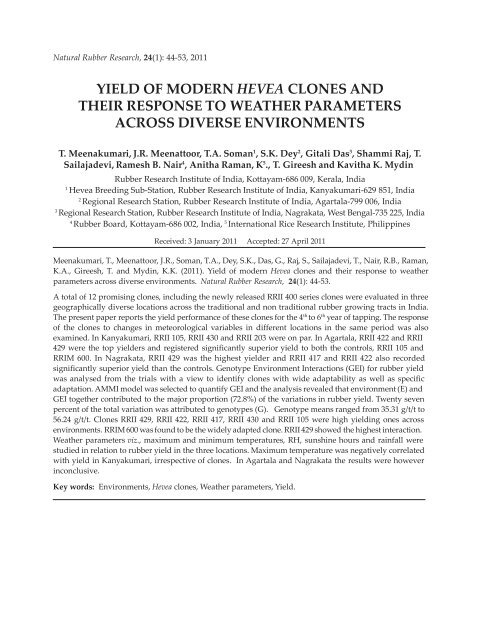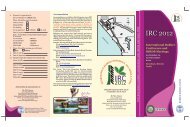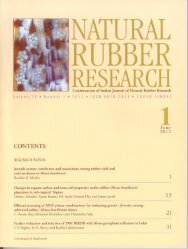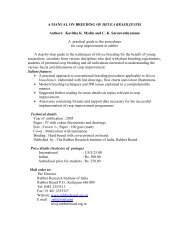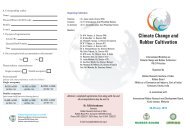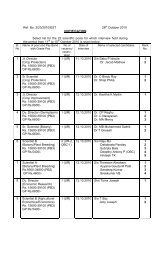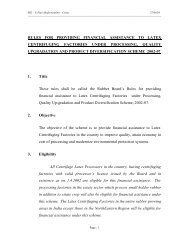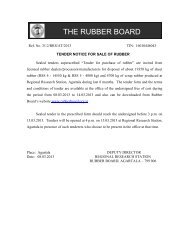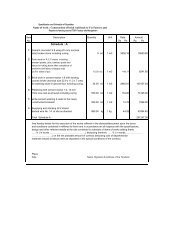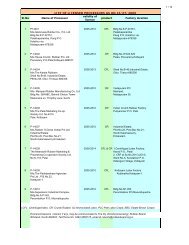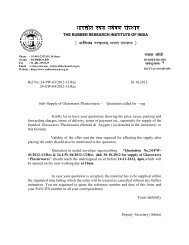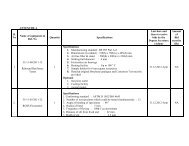to read the publication - Rubber Board
to read the publication - Rubber Board
to read the publication - Rubber Board
You also want an ePaper? Increase the reach of your titles
YUMPU automatically turns print PDFs into web optimized ePapers that Google loves.
Natural <strong>Rubber</strong> Research, 24(1): 44-53, 2011<br />
YIELD OF MODERN HEVEA CLONES AND<br />
THEIR RESPONSE TO WEATHER PARAMETERS<br />
ACROSS DIVERSE ENVIRONMENTS<br />
T. Meenakumari, J.R. Meenat<strong>to</strong>or, T.A. Soman 1 , S.K. Dey 2 , Gitali Das 3 , Shammi Raj, T.<br />
Sailajadevi, Ramesh B. Nair 4 , Anitha Raman, K 5 ., T. Gireesh and Kavitha K. Mydin<br />
<strong>Rubber</strong> Research Institute of India, Kottayam-686 009, Kerala, India<br />
1 Hevea Breeding Sub-Station, <strong>Rubber</strong> Research Institute of India, Kanyakumari-629 851, India<br />
2 Regional Research Station, <strong>Rubber</strong> Research Institute of India, Agartala-799 006, India<br />
3 Regional Research Station, <strong>Rubber</strong> Research Institute of India, Nagrakata, West Bengal-735 225, India<br />
4 <strong>Rubber</strong> <strong>Board</strong>, Kottayam-686 002, India, 5 International Rice Research Institute, Philippines<br />
Received: 3 January 2011 Accepted: 27 April 2011<br />
Meenakumari, T., Meenat<strong>to</strong>or, J.R., Soman, T.A., Dey, S.K., Das, G., Raj, S., Sailajadevi, T., Nair, R.B., Raman,<br />
K.A., Gireesh, T. and Mydin, K.K. (2011). Yield of modern Hevea clones and <strong>the</strong>ir response <strong>to</strong> wea<strong>the</strong>r<br />
parameters across diverse environments. Natural <strong>Rubber</strong> Research, 24(1): 44-53.<br />
A <strong>to</strong>tal of 12 promising clones, including <strong>the</strong> newly released RRII 400 series clones were evaluated in three<br />
geographically diverse locations across <strong>the</strong> traditional and non traditional rubber growing tracts in India.<br />
The present paper reports <strong>the</strong> yield performance of <strong>the</strong>se clones for <strong>the</strong> 4 th <strong>to</strong> 6 th year of tapping. The response<br />
of <strong>the</strong> clones <strong>to</strong> changes in meteorological variables in different locations in <strong>the</strong> same period was also<br />
examined. In Kanyakumari, RRII 105, RRII 430 and RRII 203 were on par. In Agartala, RRII 422 and RRII<br />
429 were <strong>the</strong> <strong>to</strong>p yielders and registered significantly superior yield <strong>to</strong> both <strong>the</strong> controls, RRII 105 and<br />
RRIM 600. In Nagrakata, RRII 429 was <strong>the</strong> highest yielder and RRII 417 and RRII 422 also recorded<br />
significantly superior yield than <strong>the</strong> controls. Genotype Environment Interactions (GEI) for rubber yield<br />
was analysed from <strong>the</strong> trials with a view <strong>to</strong> identify clones with wide adaptability as well as specific<br />
adaptation. AMMI model was selected <strong>to</strong> quantify GEI and <strong>the</strong> analysis revealed that environment (E) and<br />
GEI <strong>to</strong>ge<strong>the</strong>r contributed <strong>to</strong> <strong>the</strong> major proportion (72.8%) of <strong>the</strong> variations in rubber yield. Twenty seven<br />
percent of <strong>the</strong> <strong>to</strong>tal variation was attributed <strong>to</strong> genotypes (G). Genotype means ranged from 35.31 g/t/t <strong>to</strong><br />
56.24 g/t/t. Clones RRII 429, RRII 422, RRII 417, RRII 430 and RRII 105 were high yielding ones across<br />
environments. RRIM 600 was found <strong>to</strong> be <strong>the</strong> widely adapted clone. RRII 429 showed <strong>the</strong> highest interaction.<br />
Wea<strong>the</strong>r parameters viz., maximum and minimum temperatures, RH, sunshine hours and rainfall were<br />
studied in relation <strong>to</strong> rubber yield in <strong>the</strong> three locations. Maximum temperature was negatively correlated<br />
with yield in Kanyakumari, irrespective of clones. In Agartala and Nagrakata <strong>the</strong> results were however<br />
inconclusive.<br />
Key words: Environments, Hevea clones, Wea<strong>the</strong>r parameters, Yield.


